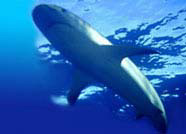


Grey Reef Shark

 |
 |
 |
|||
| Home | Evolution
| Classification
| Glossary | Biology
| Behavior | Shark
Repellent | Shark
Conservation | Do's &
Don'ts | Did You Know?
Grey Reef Shark |
 |
||||
|
 Scientific
Name: Carcharhinus amblyrhynchos Scientific
Name: Carcharhinus amblyrhynchosAlso called as Long nose Black-tail shark, Grey reef sharks are active night predators, often forming big feeding aggregations that hunt for sleeping fish on the reef. Grey reef sharks have a broad, rounded snout. They are dark grey or bronze-grey above and white below. The caudal fin has a wide, black margin and the undersides of the pectoral and pelvic fins have black tips and margins. Grey reef sharks are found around coral reefs anywhere between the surface and depths of up to 100m.These are very common in the Central Pacific Ocean. They are common on coral reefs, often in deeper areas near drop-offs to the open sea, in atoll passes and in shallow lagoons adjacent to areas of strong currents. The grey reef shark feeds on reef fish, squid, octopuses, crabs, lobsters and shrimps. These sharks form daytime schools or aggregations in favored areas. Although active during the day, they are more active nocturnally. The grey reef shark adopts a distinctive body posture as a warning when annoyed. It lifts its  snout,
points its pectoral fins downwards, arches its back and holds its tail
sideways. snout,
points its pectoral fins downwards, arches its back and holds its tail
sideways.This shark is viviparous, having litters of 1-6 pups after a gestation period of about 1-year. At birth, pups are about 2 feet (60 cm) long. Maturity is reached at 7 years of age (when they are 4.25 feet (1.3 m) long. It averages 6 feet (1.8 m) long but can be up to 8 feet (2.5 m) long The IUCN lists grey reef sharks as not threatened Statistics: These sharks can reach 2.6m (8.5ft) in length. These sharks can reach 2.6m (8.5ft) in length. Grey reef Shark Classification:
|
|||||
| Sitemap | Reach To Us | Jimtrade - Business Directory of India | |||||